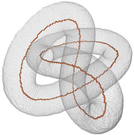There are three regular tessellations of the plane. The square and the hexagonal grids are point lattices, while the triangular gird is not a point lattice. The fundamental operations of mathematical morphology are based on translations. However, the triangular grid is not closed under translations by arbitrary grid vectors. This is related to the fact that there are two types of orientations of the triangles in the grid: there are even and odd triangles. Various solutions to define morphological operations are proposed to solve this issue with translations. In 'strict' morphologic operations, the structural elements are restricted to build up by only pixels that correspond to grid vectors translating the grid into itself. In 'weak' morphology, the previous restriction has been released, any picture can be used as a structural element, but the points translated outside the grid has been lost. In 'strong' morphology we keep also the points translated outside the grid in the memory, they may be translated back to the grid after some other operations. In this approach the images may have some non visible parts, i.e., those points which are outside the grid. We also present the 'independent' approach, in which the structural elements are formed by two sets of vectors, working independently with the two types of triangles, the even and the odd triangles of the images.

 PDF version
PDF version
